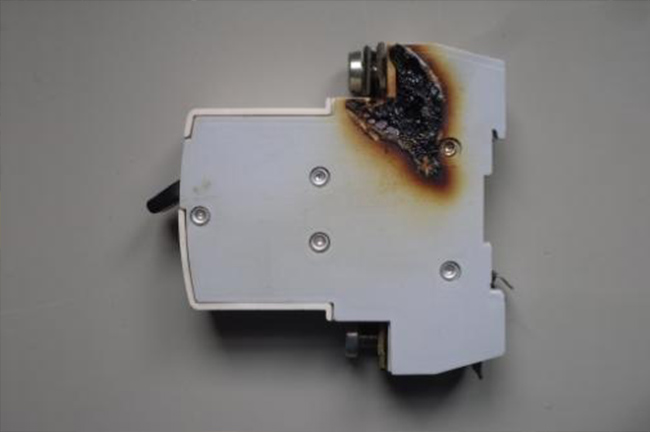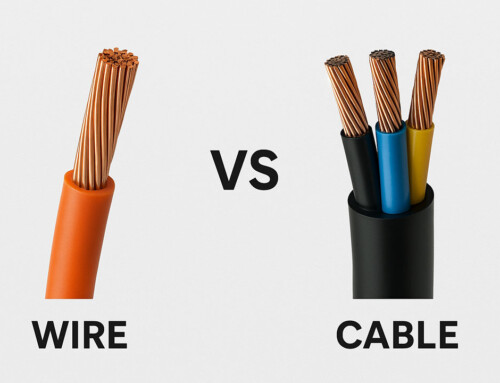Table of Contents
If you’ve got a circuit breaker that just won’t stay on, you may be dealing with a frustrating and potentially worrisome situation. Circuit breakers play a crucial role in your home’s electrical safety, and a constantly tripping one signals a problem that needs attention.
This blog is here to help you with the common causes of frequent tripping, how to troubleshoot them, and everything else. Read on to know more!
Table of Content
- What is a Circuit Breaker?
- Why Does My Circuit Breaker Keep Tripping?
- How to find what is tripping my circuit breaker?
- What to Do if Circuit Breaker Still Keeps Tripping?
What is a Circuit Breaker? (And Why Does it Trip)
An electrical circuit breaker is a switching device that can be operated automatically or manually to control and protect the electrical power system and the electrical devices connected to it.
The circuit breaker trips when too much electricity flows through it or when it cannot handle the excess current load. In layman’s terms, this situation is called an electricity trip. It means that the flow of electricity is cut off to keep your circuits from overheating or causing more damage.
If there had been no electric trips, house fires would have been quite common. Read on to learn more about this critical electric safety topic!
Why Does My Circuit Breaker Keep Tripping?
If there is frequent tripping in your circuit breaker, it indicates something is going wrong with the circuit. There may be a short circuit in one of your appliances or a ground fault. Maybe there is a circuit overload or a sign indicating the circuit breaker box is faulty. Keep an eye out for all of these reasons, especially if your main breaker keeps tripping.
If you know what causes a circuit breaker to trip, you can take action to prevent it from happening again. Let’s delve into 6 main reasons that cause circuit breakers to trip frequently(and it’s troubleshooting).
-
Overheating Appliance
One of the most frequent reasons for frequent electricity trips is an overheating appliance. When an appliance draws too much power or encounters a fault, it can lead to overheating and cause the breaker to trip.
To address this issue, it’s crucial to keep your appliances clean and well-maintained. Check for any frayed cords or damaged outlets, as these can contribute to overheating. Regularly inspect the condenser of your appliances and practice preventative maintenance to ensure they operate within safe parameters.
-
Circuit Overload
A circuit overload occurs when you want a particular circuit to provide more electricity than its actual capacity. This leads to overheating the circuit, which puts all the electrical appliances connected to the circuit at risk.
For example, suppose your television is connected to the circuit, which actually needs 15 amps but is now using 20 amps. In that case, the circuit of the television system can get fried and damaged. The circuit breaker trips to prevent this from happening, potentially even preventing a significant fire.
It’s vital to identify the overloaded circuit, switch the tripped breaker back on, and then carefully plug your appliances back in. Try to redistribute your electrical devices and keep them off of the same circuits as recommended by fellow electrical repairmen.
You can even turn off some devices to reduce the electrical load on the circuit breaker. Additionally, using energy-efficient appliances and installing dedicated circuits for high-power devices can help prevent overload-induced electric trips.
-
Short Circuits
Another common reason why power keeps tripping is a short circuit. It’s more dangerous than an overloaded circuit. A short circuit is caused when a “hot” wire comes into contact with a “neutral wire” in one of your electrical outlets. When this happens, a large amount of current flows through the circuit, creating more heat than what the circuit can handle.
Short circuits can occur for a number of reasons, such as faulty wiring or a loose connection. You can identify a short circuit by a burning smell that is usually left around the breaker. Additionally, you may notice a brown or black discoloration around it. Shut off the circuit to prevent dangerous events, such as a fire.
-
Ground Fault Surges
Ground fault surges are similar to short circuits. They occur when a hot wire touches a ground wire that is made of bare copper or the side of a metal outlet box that is connected to the ground wire. This causes more electricity to pass through it, which the circuit cannot handle.
The breaker trips in order to protect the circuit and appliances from overheating or from potential fires. If ground fault surges occur, you can identify them through discoloration around your outlet. A ground fault interrupter (GFI) outlet can help mitigate the risks associated with ground fault surges.
-
Arc Fault
Generally, arc faults is also considered to be a major reason behind frequently tripped circuit breakers. An arc fault happens when loose or corroded wires create a short contact that causes an arc or a spark. This creates heat and can risk an electrical fire. If you hear your light switch hissing or the outlet buzzing, you are experiencing an arc fault.
If you avoid or overlook any of these problems, you are putting the safety of your home and loved ones at great risk. To address this issue, consider installing an arc-fault circuit interrupter (AFCI) to enhance the protection of your electrical system. Remember to call in the professionals to investigate the problem. Do not try to handle this issue on your own.
-
Defective Circuit Breaker
What if you find out that the reasons mentioned above are not why your circuit breaker keeps tripping? Well, in that case, maybe your circuit breaker is at fault. When the breaker is old and cannot produce electricity anymore, it’s time to replace it. Also, a breaker is bound to wear out if not maintained.
If your breaker has gone bad, you may experience a burnt smell, frequent tripping, and inability to reset or scorch marks on the breaker box. If you suspect a faulty breaker, it’s advisable to have it inspected and replaced by a qualified electrician to maintain the reliability and safety of your electrical system.
How to Find What is Tripping my Circuit Breaker?
When a circuit breaker trips, it means there is an electrical problem that needs to be addressed. To find out what is causing the breaker to trip, follow these steps:
- Turn off all the devices and appliances that are connected to the circuit that is tripping the breaker.
- Reset the circuit breaker by flipping it to the “off” position and then back to the “on” position.
- Turn on each device one at a time and see if the breaker trips again.
- If the breaker trips when a specific device is turned on, unplug that device and try plugging it into a different circuit.
- If the breaker does not trip when the device is plugged into a different circuit, then the problem is likely with the original circuit.
- If the breaker continues to trip even with all devices and appliances unplugged, the problem may be a short circuit or a faulty breaker.
If you are not comfortable with or qualified to deal with electrical issues, it is best to contact a licensed electrician to diagnose and fix the problem.
What to Do if Circuit Breaker Still Keeps Tripping?
If a circuit breaker keeps tripping even after trying the troubleshooting steps mentioned earlier, it’s best to get in touch with an electrician and have them look into it. In the meantime, for your safety, you can also try inspecting it yourself using these methods with appropriate caution.
- Unplug Devices: Manually switch off any devices and then unplug them. This is necessary because once the power surges back and the devices are still on, it might affect them adversely.
- Reset the Circuit Box: Go to the circuit breaker and switch it off or remove the fuse. Turn it on again. This is how you reset a circuit breaker.
- Check the Reasons: Inspect the circuit box again and check whether any of the above reasons tick the current situation of your circuit breaker.
- Switch on the Devices: You need to test the circuit by switching on all the lights and appliances you unplugged. This gives you an idea of what is causing the breaker to trip.
- Check or Replace: Once you check all the devices, decide whether you need to replace the circuit breaker with a new one. It is critical to treat electrical issues carefully. If your circuit breaker keeps tripping, it means something isn’t right. Understanding why it is happening frequently and how to diagnose and cure this problem can help you keep your house safe and prevent damage. However, it is always advisable to call a licensed electrician if such issues persist.
Conclusion:
A tripping circuit breaker is a warning sign that something is amiss within your electrical system. Understanding the basics of how circuits work and simple troubleshooting can help you pinpoint easy fixes. As mentioned earlier, electrical issues can be complex. Contact a qualified electrician when dealing with repeated trips.
FAQs:
-
What is The Purpose of a Circuit Breaker?
A circuit breaker is a safety device that cuts off the power supply when there is an overload or short circuit in the circuit. It prevents damage to electrical devices and wiring and protects people and property from electrical hazards.
-
How Circuit Breaker Works?
A circuit breaker works by detecting the amount of current flowing through the circuit, and if it exceeds a certain limit, it trips and opens the circuit. This interrupts the flow of electricity and prevents damage to the circuit and electrical appliances. Once the fault has been cleared, the circuit breaker can be reset, and the power supply restored.
-
What Are The Signs of a Faulty Circuit Breaker?
Circuit breakers can develop faults over time. Look out for a burning smell, power outages in specific areas, frequent tripping, inoperable electrical outlets, scorch marks or damage on the circuit box, and a red light signaling a tripped breaker. Also, note if the breaker remains “OFF” or fails to stay in the reset mode.
-
How to Reset Circuit Breaker?
To reset a tripped circuit breaker, turn it off and then on again. Be sure to stand at a safe distance from the panel and wear safety goggles. Before unplugging devices, reset the breaker to determine the cause of the trip. Remember that circuit breakers prevent overheating and electrical risks, so follow guidelines to keep your house safe and best consult an electrician if you don’t understand it.
-
What is The Difference Between a Fuse And a Circuit Breaker?
Fuses and circuit breakers both protect electrical circuits from overloading or short-circuiting. Fuses contain a metal wire that melts when the current exceeds a certain limit, while circuit breakers use an electromechanical switch that trips and disconnects the circuit. Fuses need to be replaced after they blow, while circuit breakers can be reset and reused.
-
Is it Dangerous if The Circuit Breaker Keeps Tripping?
If your circuit breaker keeps tripping, it could indicate a potentially dangerous electrical issue. It’s best to have a licensed electrician inspect your electrical system as soon as possible to identify and resolve the problem rather than continuing to reset the breaker. Ignoring the issue could lead to overheating, electrical fires, and other hazards.
-
How do I Fix a Circuit Breaker That Keeps Tripping?
To fix a circuit breaker that keeps tripping, try unplugging all devices connected to the circuit and resetting the breaker. If the issue persists, check for loose or damaged wires, reduce the amount of power being used on the circuit, or replace the old/damaged circuit breaker. Remember, electrical work can be dangerous, so consider calling a licensed electrician for help if you’re unsure.
-
How to Tell if a Circuit Breaker is Bad?
If your circuit breaker trips frequently, feels hot to the touch, shows signs of physical damage or discoloration, or emits burning smells or popping sounds, it may be a sign that it needs to be replaced.
-
Can I Replace a Circuit Breaker Myself?
While it’s possible to replace a circuit breaker yourself, electrical work can be dangerous and should only be attempted by experienced individuals. If you’re not confident in your abilities, it’s best to hire a professional electrician. Always turn off the power and follow safety precautions.






